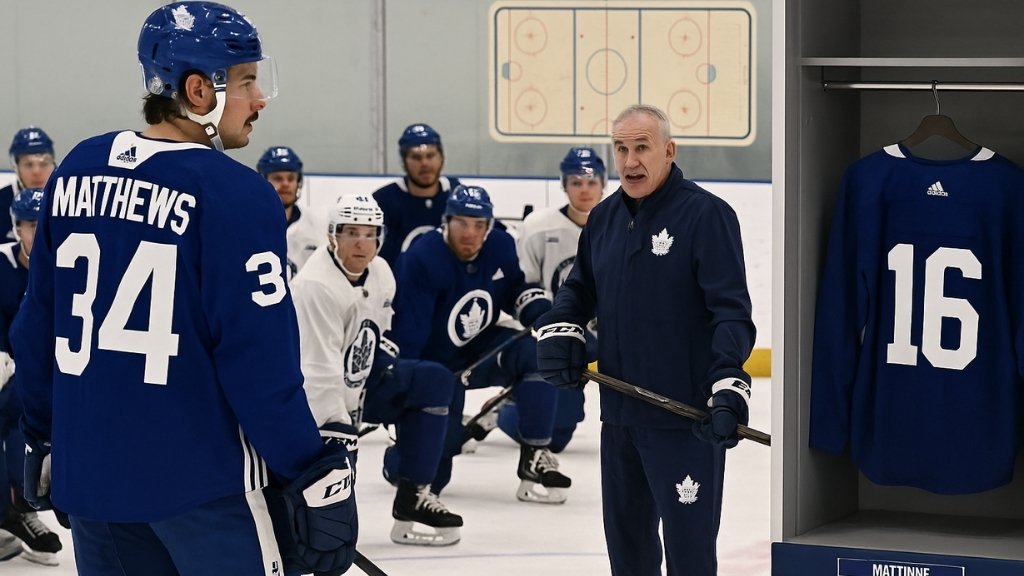Training camp opened with the Toronto Maple Leafs addressing the most visible change of their era: moving forward without Mitch Marner. Captain Auston Matthews and the leadership group framed the moment not as an elegy but as an inflection point, signaling a cultural pivot from star-centric narratives to collective identity.
General manager Brad Treliving underscored that the organization has “turned the page,” not by hunting for a one-for-one replacement, but by rebalancing roles, deepening the lineup, and trusting Craig Berube to embed a sturdier, all-situations structure across the roster. The message from day one was unmistakable: accountability and role clarity trump labels, and the team intends to build an offence-plus-defence identity that is harder to game-plan against.
Top-Line Tryouts Without Panic
Craig Berube sketched an immediate plan to audition options alongside Matthews and Matthew Knies, with newcomer Matias Maccelli expected to get the earliest look on the flank. The fit is appealing on paper: Maccelli’s pass-first instincts and controlled-entry craft can grease quick give-and-go sequences with Matthews while freeing Knies to do force-of-nature work at the net front.
Berube also acknowledged that Max Domi is in the mix for a top-line cameo when healthy, but the staff’s emphasis is on combinations that complement skill with retrievals, forecheck layers, and responsible backside pressure through the neutral zone. Rather than anointing a replacement, the Maple Leafs are treating the spot as a competition that will evolve through camp reps, preseason pace, and special-teams performance.
Managing Early Injury Hurdles
Treliving confirmed that Domi is day-to-day with a lower-body issue from the lead-up to camp, tempering immediate plans to test him full-tilt with the first unit. The designation suggests short-term caution rather than structural concern, but it does hand Maccelli a window to seize chemistry with Matthews and Knies against NHL speed. Toronto’s view is that the role should be earned, not granted, and that small early disruptions are acceptable if they create clarity on who can drive play and survive tough matchups. The coaching staff’s north-south demands will be constant regardless of who occupies the right side.
Why Maccelli Matters Right Now
Beyond the headline audition, Maccelli’s toolkit answers specific post-Marner problems: controlled entries against set lines, deceptive east-west feeds that pull penalty kills apart, and patience on the half wall that can buy Matthews an extra stride into shooting pockets. He arrives motivated to prove he is more than a sheltered playmaker, openly stating he wants a top-six role and a real playoff run. If he sticks, Toronto can redistribute touches more evenly across the top nine without overloading one line, while giving the second unit a pass hub that improves puck movement and shot quality.
Turning “Core Four” Into Team-First
Removing Marner from the equation inevitably changes the way the room is discussed externally, but internally the goal is to replace production by committee and reinforce habits that travel in spring. Berube’s arrival complements that aim: his teams are known for demanding details on exits, backpressure, and wall work that protect defencemen and shorten defensive shifts.
The Leafs believe that if their five-man spacing tightens, Morgan Rielly’s puck-moving value re-emerges naturally and the forwards spend more time attacking with numbers. The group’s early tone—serious, professional, and light on nostalgia—reflects a conscious effort to define themselves by results rather than reputations.
What Success Looks Like in Preseason
In the short term, success won’t be measured by highlight-reel chemistry but by repeatable sequences: clean exits under pressure, quick neutral-zone counters, and layered entries that yield middle-ice looks instead of low-percentage point shots.
The staff wants to see penalty-kill pairs that close seams by instinct, a power play that relies less on telegraphed patterns, and a third line capable of tilting ice without being sheltered. Domi’s return will add a different pace and snarl to those experiments, but the template won’t shift—Toronto intends to build redundancy so injuries or slumps don’t collapse their scoring ecosystem.
The Matthews Factor
None of this works without a locked-in captain. Early readouts around the facility describe Matthews as physically sharp and mentally dialed, with a seriousness that aligns with Berube’s demand for purposeful details. A stable, trustworthy top-six running mate would allow him to vary his attack—arriving late into space, posting up in the slot, or drawing defenders wide to spring Knies underneath—rather than shouldering every controlled entry himself. The Leafs aren’t scripting a Hart campaign; they’re scripting a playoff-proof style.
Bottom Line: Identity Over Narratives
Day one captured the essence of this Maple Leafs reset: admiration for what Marner meant, matched by an insistence on evolving past the shorthand of old cores and familiar debates. By spreading responsibility, testing top-line candidates, and baking in a more assertive five-man structure, Toronto is betting that being harder to play against—and less predictable—will matter more in April than any headline in September. The plan isn’t about replacing a single star; it’s about raising the collective floor while preserving elite ceiling through Matthews and a hungrier supporting cast.







